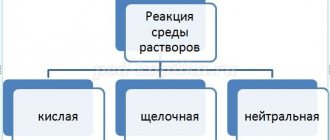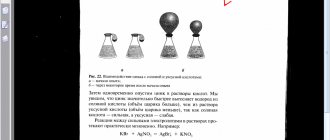Oil and methods of its processing
As is known, the main sources of hydrocarbons are natural gas
,
oil
and
coal
.
Natural gas consists mainly of methane, with small amounts of ethane, propane, and isomeric butanes.
Oil deposits are found in the bowels of the Earth at different depths, where oil fills the free space between some rocks. If it is under gas pressure, it rises through the well to the surface of the Earth. Russia occupies one of the leading places in the world in terms of oil reserves.
Depending on the field, oil has different qualitative and quantitative composition. For example, Baku oil is rich in cycloparaffins and relatively poor in saturated hydrocarbons. There are significantly more saturated hydrocarbons in Grozny and Fergana oil.
The origins of modern ideas about the origin of oil arose in the 18th and early 19th centuries. M.V. Lomonosov laid down hypotheses of the organic origin of oil, explaining its formation by the influence of “underground fire” on “fossil coals”, as a result of which, in his opinion, asphalts, oils and “stone oils” were formed. The idea of the mineral origin of oil was first expressed by A. Humboldt in 1805.
In 1892, M. A. Sokolov put forward a hypothesis of the cosmic origin of oil. Its essence comes down to the same mineral synthesis of hydrocarbons from simple substances, but at the initial, cosmic stage of the formation of the Earth. It was assumed that the resulting hydrocarbons were in a gas shell, and as they cooled, they were absorbed by the rocks of the forming earth's crust. Then released from the cooling igneous rocks, hydrocarbons rose to the upper part of the earth's crust, where they formed accumulations. This hypothesis was based on data on the presence of carbon and hydrogen in the tails of comets and hydrocarbons in meteorites.
Oil consists of a mixture of saturated
and
cyclic hydrocarbons
, which have 50 or more carbon atoms.
The very first stage of oil refining is its distillation
. Using distillation, oil is separated into fractions - mixtures of substances with similar boiling points. As is known, the greater the molecular weight of a hydrocarbon, the higher its boiling point.
When distilling oil, the following fractions are formed:
· gases (C1 – C4);
· petroleum ether (C5 – C7);
· gasoline (C5 – C11);
· kerosene (C12 – C18);
· diesel fuel (C18 and higher).
The Dubinin brothers were the first to create a device for oil distillation. Since 1823, the Dubinins began to export photogen (kerosene) in many thousands of pounds from Mozdok into Russia. The Dubinins' plant was very simple: a boiler in a stove, a pipe goes from the boiler through a barrel of water into an empty barrel. A barrel with water is a refrigerator, an empty one is a receiver for kerosene.
Petroleum ether
used as a solvent, kerosene as fuel for aircraft engines, gas oil as fuel for diesel engines (cars and tractors).
Fuel oil
- residue from distillation. Contains hydrocarbons with a large number of carbon atoms (up to many tens) in the molecule. Fuel oil is also divided into fractions:
· solar oils;
lubricating oils;
Vaseline
After fractional distillation of oil comes cracking
, which consists of splitting hydrocarbons with a large relative molecular weight into hydrocarbons with a small molecular weight.
There are thermal cracking
and
catalytic
. Thermal cracking occurs at a temperature of 450-550 0C, and light oil fractions are obtained. If thermal cracking occurs at temperatures above 750 C0, then alkenes are obtained.
Cracking was invented by Russian engineer V. G. Shukhov in 1891. In 1913, Shukhov's invention began to be used in America. Currently in the United States, 65% of all gasoline is produced at cracking plants.
Vladimir Grigorievich Shukhov is a builder and mechanic, oil worker and heating engineer, hydraulic engineer and shipbuilder, scientist and inventor. More than 500 steel bridges were built according to Shukhov's designs. Shukhov was the first to propose using simple connections with rivets instead of complex hinges. Shukhov’s work on the construction of metal mesh shells is extremely interesting. Invented oil cracking. The oil pipelines through which oil is pumped are also made according to his formulas. Oil storage tanks are also his achievement.
During thermal cracking
the C–C bond breaks, resulting in the formation of mixtures of hydrocarbons with a low octane number.
Octane number
– an indicator characterizing the detonation resistance of fuel (the ability of the fuel to resist self-ignition during compression) for internal combustion engines.
That is, the octane number of a straight-chain hydrocarbon, namely heptane, is taken as 0, and the octane number of a branched-chain hydrocarbon, namely isooctane, or 2,2,4-trimethylpentane, is taken as 100.
Accordingly, anti-knock resistance is determined by the octane number, which depends on the structure of hydrocarbons. The higher the octane number, the better anti-knock properties the gasoline has. Higher octane numbers are typical for hydrocarbons with a branched structure.
For example, the octane number of hexane is 19, cyclohexane is 110, isobutane is 122, isopropylbenzene is 132, and 1,2,4-trimethylbenzene is 171.
Previously, tetraethyl lead, which is an extremely toxic substance, was added to increase the octane number of fuel.
Catalytic cracking is used to produce branched hydrocarbons.
. This cracking occurs in the presence of a catalyst, resulting in hydrocarbons containing from 5 to 11 carbon atoms and having a branched structure, which have a higher octane number.
Thus, isobutane is produced from butane by catalytic cracking.
Reforming
– (from the English
r eforming
- “remake”, “improve”) the industrial process of processing gasoline and naphtha fractions of oil in order to produce high-quality gasoline and aromatic hydrocarbons. In this case, hydrocarbon molecules are mainly not broken down, but transformed. The raw material is the petroleum naphtha fraction.
The main products of oil refining are: raw materials for the chemical industry, asphalt, oils, aircraft fuel, lubricants, diesel fuel and automobile fuel.
Despite the fact that oil and its products are widely used by humans, their pollution of the environment leads to environmental problems. It is very dangerous for oil and petroleum products to enter water bodies; this can lead not only to the death of animals, but also to their entry into drinking water.
When burning various types of fuel, in addition to carbon dioxide, substances dangerous to human health are also formed, such as carbon monoxide (II) and nitrogen oxides.
When fuel burns, a large amount of carbon monoxide (IV) is released, which leads to the so-called “greenhouse effect”, that is, an increase in temperature on our planet.
Thus, oil refining consists of its distillation. The next stage is thermal and catalytic cracking, which consists of isomerization and splitting of hydrocarbons with a higher molecular weight into hydrocarbons with a lower molar mass. Branched hydrocarbons have higher octane numbers.
Download material
so UNT / Lesson developments / Chemistry lessons
Lesson summary on chemistry topic “Oil. Composition. Industrial oil refining.
01/04/2016 1794 415 Leontyeva Elena Algisovna
Topic: Oil. Compound. Industrial oil refining
Purpose: To familiarize students with oil. Consider industrial oil refining.
During the classes
Organizational point: student motivation (quantity “5”)
Word to the leader
Updating the subjective experience of students
I. Cross survey (checking homework) each correct answer is “plus” in the MPM
1. Name the natural sources of Hydrocarbons (oil, coal, natural and associated petroleum gases)
2. Composition of natural gas (mixture of hydrocarbons with low molecular weights, the main part is methane 80-96%)
3. What is associated with the name associated petroleum gas (gas is located above the surface of the oil or dissolved in it)
4. What two fractions is natural gas divided into (dry gas - a mixture of methane and ethane, propane-butane mixture)
5. How to obtain soot, hydrogen, and solvents from dry gas (by cracking)
6. Name the areas of application of natural gas (valuable raw materials for the chemical industry and cheap fuel)
7. How is propane-butane mixture converted into chemically active unsaturated hydrocarbons (by dehydrogenation)
8. How much heat is released during the combustion of 1 m3 of natural gas (54,400 kJ of heat)
9. What is the difference between associated gas and natural gas (it contains half as much methane)
Organization of primary consolidation
VI.
Critical survey (for the correct answer “plus” in the MPM)
1.
The most effective transportation of oil is road tanks (no, pipeline)
2. Oil is a complex substance consisting of carbon, hydrogen, sulfur, oxygen, nitrogen (no, it is a mixture of hydrocarbons, nitrogen-, oxygen- and sulfur-containing compounds, mineral salts, water)
3. Cracking is the separation of hydrocarbons with different molecular weights into fractions (no, this is the transformation of high molecular weight hydrocarbons into low molecular weight ones)
4. The Dossor, Makat, Emba fields are rich in aromatic hydrocarbons (no, naphthenic)
5. The cracking process was first developed by the Russian engineer V.G. Shukhov (yes)
6. Inside the distillation column, oil is divided into fractions of solid substances with different boiling points (no, fractions of liquid substances with similar boiling points)
7. Oil extracted from the depths of the earth is called commercial oil (no, crude)
8. Distillation is the transformation of high molecular weight hydrocarbons into low molecular weight ones (no, division into fractions, division into hydrocarbons with different molecular weights)
9. In the distillation column, hydrocarbons are divided into spindle oil, machine oil, light cylinder oil, etc. (no, gasoline, legroin, kerosene, gas oil, fuel oil)
10. An oil refining plant consists of a chamber and a gas collector (no, a tube furnace and a distillation column)
11. Railway tanks with a length of 350 m can transport up to 600,000 tons of oil per trip (no, supertankers, 500,000 tons)
12. Oil purified from water and gas impurities is called crude (no, it’s called commercial)
13. The yield of gasoline during oil distillation is insignificant and amounts to 15-20% (yes)
14. The Uzen and Zhetibay fields are rich in naphthenic hydrocarbons (no, paraffins)
15. Oil is a yellow liquid, with a pungent odor, highly soluble in water, non-flammable, heavier than water (no, an oily, viscous liquid of a dark color with a peculiar odor, insoluble in water, flammable, density 0.73-0.98 g/ml , dissolves in organic solvents)
16. To improve the quality of oil and reduce losses during production, crude oil is immediately transported (no, it settles, passes through a separator, separating it from water and gases)
17. Oil from the Northern Bozashi field is viscous, so deep-well pumps are installed in the well (yes, oil from some fields is viscous)
18. The tube furnace is heated by coal (no, fuel oil or gas)
19. Inside the distillation column there are vertical partitions with holes (no, horizontal plates, each plate has holes with a cap)
20. Oil entering the pipeline of a tube furnace is heated to 3500C (yes)
21. To facilitate the evaporation of hydrocarbons, cooled steam (superheated steam) is periodically supplied from below
22. Oil refining consists mainly of four processes (no, two: distillation and cracking)
Analysis
VII.
Thematic vocabulary.
The words are legible without shortening, it can be in the form of an essay or essay. When calculating, prepositions and conjunctions are not taken into account. (norm - 63 words) Students who succeed receive a “plus” in the MPM (5 minutes) VIII.
Estimates
IX. D/Z
Students with less than 4 marks §2.17 questions 1-6 p.141
u.14,15 p.142
See the downloadable file for the full text of the material.
The page contains only a fragment of the material.






